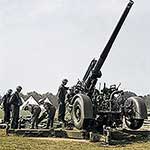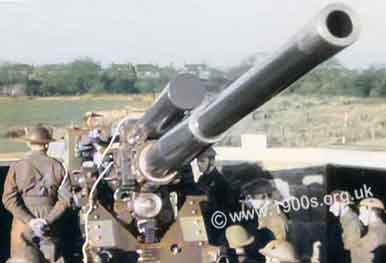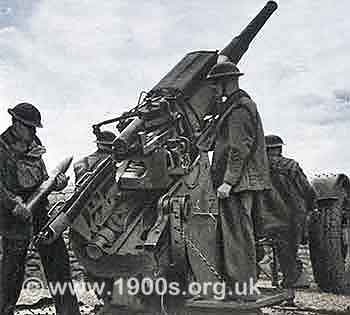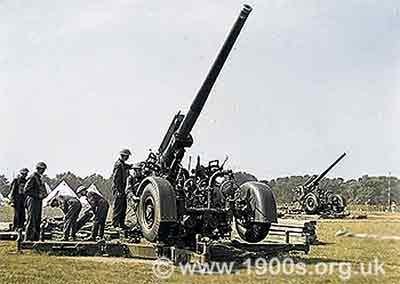WW2 anti-aircraft guns fight back against WW2 enemy aircraft

In the UK during WW2, the following terms were in everyday speech: 'gun battery', 'anti-aircraft gun' and 'ack ack'. This page explains what they meant and considers the mobility and effectiveness of the guns. The page continues with experiences of them from the people who were alive at the time.
____
By the webmaster based on information and contributions from older people and research in museums
Meanings of 'gun battery, 'anti-aircraft gun', and 'ack ack'
There seems to be no agreed or definitive definition of 'gun battery' on the internet. As far as I can make out, a World War Two British gun battery was a military grouping armed with one or more large guns capable of repeat shooting at German aircraft. The guns were known as 'anti-aircraft guns' because their targets were aircraft, and because they were repeat shooting, they made a noise sounding like 'ack ack'. Consequently they were often known as 'ack acks' in conversation.

Anti-aircraft-gun viewed from the front.

Anti-aircraft-gun viewed from the back. Note that the guns are on wheels.

Anti-aircraft-battery of several guns.
Size of gun batteries
Judging by the numbers of mentions of gun batteries and anti-aircraft guns among the contributors to this website, they were by no means uncommon across areas which anticipated air raids. I gained the impression - rightly or wrongly - that these were generally small local ones with only one or maybe two guns. However, there tended to be more guns in certain areas.
Effectiveness of anti-aircraft guns
I understand that the anti-aircraft guns of the time were not very effective. They were, after all, trying to hit a moving target at a distance. Apparently, though, they gave the civilians on the ground some sense of security.
Recollections of gun batteries, anti-aircraft guns and ack acks
I was too young to understand much about how Britain fought back during World War Two air raids. The following recollections come from people just a few years older than me.
Location of gun batteries
contributed by Neil Cryer, recollections and reflections
The gun battery that I knew was on a hill, and I believe that this was fairly general if the lie of the land permitted. It made sense as it meant that the operators had a wider field of view.
Mobility of gun batteries
contributed by Frank Clarke, personal recollections
A battery of guns was very mobile and could be rushed to various places when needed. The could point high into the sky.
Size of gun batteries
contributed by Frank Clarke, personal recollections
Gun batteries that I knew were usually quite large, usually 6-12 guns but I was close to a factories and a hospital.
Shells and flak from anti-aircraft guns
contributed by Frank Clarke, personal recollections
Anti-aircraft guns generally handled approximately 3-inch shells which were guided by a crude sonic direction and optical range finder. A shell could be fused to explode at a certain height just before firing. Then the casing split into hundreds of pieces called shrapnel, potentially dangerous to planes and airmen. Aircraft on the receiving end called it flak.
What WW2 shrapnel was
contributed by Nei Cryer, from what an engineer told me
Contrary to what many a schoolboy thought, the shrapnel that they collected was not from enemy aircraft shot down, but from British and German exploded shells that hadn't found their target.
The frightening sound of ack ack fire
contributed by Frank Clarke, personal recollections
During the blitz, there was an Ack Ack gun battery near us and most nights when they fired, it was more scary than the bombing. A great source of shrapnel for the kids but too dangerous to be out there during a raid.
Listening to gun battery fire passes the time in air raids
contributed by Richard Ouston, personal recollections
One of the ways of passing time in our so-called 'shelter' was to count the number of bangs created by the gun firing from a gun battery about 500 yards from us.
A thrill for child at a gun battery site
contributed by Richard Ouston, personal recollections
Around 1943 I was taken to see the gun in the gun battery near us. I was totally thrilled to be invited to sit on the gunner's chair and pretend to fire it.
contributed by Tom Wallace, personal recollections
We were lucky in Hazel Close, where we lived because there was an anti-aircraft battery nearby, so the German aircraft tried to avoid the area.
| sources | webmaster | contact |
Text and images are copyright
If you can add anything to this page or provide a photo, please contact me.



